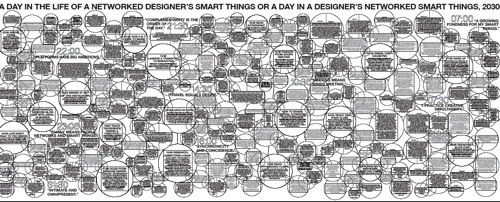Future of Media
ACM's Interactions magazine
Submitted on Thu, 05/08/2008 - 20:10 — Greg Van Alstyne I'm surprised I didn't know this one already: http://interactions.acm.org/ Interactions is a bimonthly publication of the Association for Computing Machinery (ACM) and is distributed to all members of SIGCHI. Lots of interesting things in here and broader than I expected, e.g.:
If Networked Smart Things Could Draw Self Portraits...
Submitted on Sun, 04/27/2008 - 20:41 — Greg Van Alstyne I rediscovered this Boing Boing post that was shared by Mark Kusnicki last year:
Designers Irene Pereyra and Tom Klinkowstein recently exhibited their wall-sized digram called "A Day in the Life of a Networked Designer's Smart Things or A Day in a Designer's Networked Smart Things, 2030." The map not only presents a narrative of how a designer "gets things done with the help of all her smart things" but at a higher level also seems to hint at how we may deal with mass amounts of information in the future.
Interactivos?'08 · Vision Play: Open call for projects (co-lead by OCAD's Simone Jones)
Submitted on Mon, 03/17/2008 - 21:11 — Greg Van Alstyne Medialab-Prado issues a call for the submission of projects to be Project development advanced workshop With the participation of the research group Light, space and
Another PARC reference for Smart Book
Submitted on Wed, 03/12/2008 - 20:28 — Greg Van Alstyne Here's an interesting paper from PARC. I don't buy the premise -- to create a 3D virtual book -- but the paper raises some useful overlaps with our smart book idea, e.g. references, context, vocabulary. http://citeseer.ist.psu.edu/card04book.html Abstract: This paper describes the 3Book, a 3D interactive visualization of a codex book as a component for various digital library and sensemaking systems. The book is designed to hold large books and to support sensemaking operations by readers. The book includes methods in which the automatic semantic analysis of the book's content is used to dynamically tailor access. (Update)
Assessing 2D barcodes for Smart Book functionality
Submitted on Thu, 03/06/2008 - 14:14 — Greg Van Alstyne One option for 'automating links' in the smartbook might be to use 2D barcodes to link to the virtual version of the book, plus additional resources etc. This post assesses potential for 2D barcodes incl. prelim. SWOT analysis.
Smart Book concept precedent: Mark Weiser at PARC (of course)
Submitted on Tue, 03/04/2008 - 18:08 — Greg Van Alstyne Kevin Kelly's prescient 1994 book Out of Control is online its entirety, searchable, linkable etc. This chapter covers the smart book concept as envisioned early on, naturally enough by one of the progenators of dataspace: Mark Weiser at Xerox Parc http://www.kk.org/outofcontrol/ch10-b.html
SmartBook 2
Submitted on Mon, 03/03/2008 - 15:09 — logan1939 The “Smart Tagged” Book that is Smart, Readable and Searchable: Prepared by Robert K. Logan ()
SmartBook 1
Submitted on Mon, 03/03/2008 - 15:05 — logan1939 The “Smart Tagged” Book that is Smart, Readable and Searchable: A Potential Motorola – Google – Lulu.com – Beal Centre Collaboration Abstract: We are proposing a book that is smart, searchable and readable. We will analyze this opportunity using the New Product Filter developed at the Beal Centre.
Family Inchoate – version 03-28-3008
Submitted on Tue, 02/19/2008 - 14:14 — mark_outhwaite Family Inchoate: Prepared by Mark Outhwaite | March 2008.
Tags:
GVA speaking next Fri in Together Elsewhere: Toronto/Montreal/Lille
Submitted on Wed, 01/23/2008 - 16:34 — Greg Van Alstyne On Friday Feb. 1st, I'll be speaking in this Ryerson University-organized international conference:
12next ›last »
|

